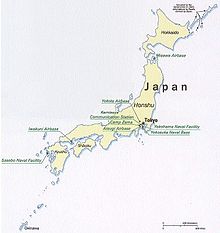
The Okinawa diet describes the traditional dietary practices of indigenous people of the Ryukyu Islands (belonging to Japan), which were claimed to have contributed to their relative longevity over a period of study in the 20th century. [1]

The Okinawa diet describes the traditional dietary practices of indigenous people of the Ryukyu Islands (belonging to Japan), which were claimed to have contributed to their relative longevity over a period of study in the 20th century. [1]
As assessed over 1949 to 1998, people from the Ryukyu Islands (of which Okinawa is the largest) had a life expectancy among the highest in the world (83.8 years vs. 78.9 years in the United States), [2] although the male life expectancy rank among Japanese prefectures plummeted in the 21st century. [3] [4]
Okinawa had the longest life expectancy in all prefectures of Japan for almost 30 years prior to 2000. [5] The relative life expectancy of Okinawans has since declined, due to many factors including Westernization. [3] [4] In 2000, Okinawa dropped in its ranking for longevity advantage for men to 26th out of 47 within the prefectures of Japan. [3] In 2015, Japan had the highest life expectancy of any country: 90 years for women and for men, 84 years. [6]
Although there are myriad factors that could account for differences in life expectancy, calorie restriction and regular physical activity could be factors. [2] People have promoted the "Okinawa diet", despite the fact that the diet alone is unlikely to solely explain high life expectancy among seniors on Okinawa in the 20th century. [7]
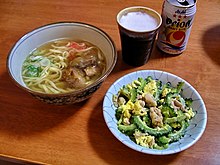
The traditional diet of the islanders contained sweet potato, green-leafy or root vegetables, and soy foods, such as miso soup, tofu or other soy preparations, occasionally served with small amounts of fish, noodles, or lean meats, all cooked with herbs, spices, and oil. [8] Although the traditional Japanese diet usually includes large quantities of rice, the traditional Okinawa diet consisted of smaller quantities of rice; instead the staple was sweet potato. [2] [8] The Okinawa diet had only 30% of the sugar and 15% of the grains of the average Japanese dietary intake. [2]
Okinawan cuisine consists of smaller meal portions of green and yellow vegetables, soy and other legumes, relatively small amounts of rice compared to mainland Japan, as well as occasional fish and pork. The center of the Okinawan cuisine is the sweet potato. Not only is the sweet potato tuber used but so are the leaves from the plant. The leaves are used often in miso soup. In Okinawa, the bitter melon is called goya and is served in the national dish, gōyā chanpurū. [6]
The dietary intake of Okinawans compared to other Japanese circa 1950 shows that Okinawans consumed: fewer total calories (1785 vs. 2068), less polyunsaturated fat (4.8% of calories vs. 8%), less rice (154g vs. 328g), significantly less wheat, barley and other grains (38g vs. 153g), less sugars (3g vs. 8g), more legumes (71g vs. 55g), significantly less fish (15g vs. 62g), significantly less meat and poultry (3g vs. 11g), less eggs (1g vs. 7g), less dairy (<1g vs. 8g), much more sweet potatoes (849g vs. 66g), less other potatoes (2g vs. 47g), less fruit (<1g vs. 44g), and no pickled vegetables (0g vs. 42g). [2] As proportions of total caloric intake, foods in the traditional Okinawa diet included sweet potato (69%), rice (12%), other grains (7%), legumes including soy (6%), green and yellow vegetables (3%), refined oils (2%), fish (1%) and seaweed, meat (mostly pork), refined sugars, potato, egg, nuts and seeds, dairy and fruit (all <1%). [2] Specifically, the Okinawans circa 1950 ate sweet potatoes for 849 grams of the total 1262 grams of food that they consumed, which constituted 69% of their total daily calories. [2]
The traditional Okinawan diet as described above was widely practiced on the islands until about the 1960s. [2] Since then, dietary practices shifted towards Western and mainland Japanese patterns, with fat intake rising from about 6% to 27% of total caloric intake and the sweet potato being supplanted with rice and bread. [9]
Another low-calorie staple in Okinawa was seaweed, particularly, konbu or kombu. [6] This plant, like much of the greenery from the island, is rich in protein, amino acids and minerals such as iodine. Another seaweed commonly eaten was wakame, which is rich in minerals like iodine, magnesium and calcium. Seaweed and tofu in one form or other were eaten on a daily basis. [10]
Okinawans ate three grams total of meat – including pork and poultry – per day, substantially less than the 11-gram average of Japanese as a whole in 1950. [2] The pig's feet, ears, and stomach were considered as everyday foodstuffs. [11] In 1979 after many years of Westernization, the quantity of pork consumption per person a year in Okinawa was 7.9 kg (17 lb), exceeding by about 50% that of the Japanese national average. [12]
In addition to their relative longevity identified in the mid-20th century, islanders were noted for their low mortality from cardiovascular disease and certain types of cancers. One study compared age-adjusted mortality of Okinawans versus Americans and found that, during 1995, an average Okinawan was 8 times less likely to die from coronary artery disease, 7 times less likely to die from prostate cancer, 6.5 times less likely to die from breast cancer, and 2.5 times less likely to die from colon cancer than an average American of the same age. [2] Though more than 10% of the Okinawans suffered from cheilosis from a low consumption of vitamin B2. [2] Delayed menstruation and deficient lactation were also relatively frequent at 9% and almost 18% due to low caloric intake and/or low body fat levels in women. [2] In the 21st century, the shifting dietary trend coincided with a decrease in longevity, where Okinawans actually developed a lower life expectancy than the Japanese average. [3]
Overall, the traditional Okinawa diet led to little weight gain with age, low body mass index throughout life, and low risk from age-related disease. [2] No ingredients or foods of any kind have been scientifically shown to possess antiaging properties. [13]
In the 1972 Japan National Nutrition Survey, it was determined that Okinawan adults consumed 83% of what Japanese adults did and that Okinawan children consumed 62% of what Japanese children consumed. [2] Since the early 2000s, the difference in life expectancy between Okinawan and mainland Japanese decreased, possibly due to Westernization and erosion of the traditional diet. [3] [4] The spread of primarily American fast-food chains was linked with an increase in cardiovascular diseases, much like the ones noted in Japanese migrants to the United States. [3] [4]
Okinawa and Japan have food-centered cultures. Festivities often include food or are food-based. Moreover, the food tends to be seasonal, fresh and raw. Portion sizes are small and meals are brought out in stages that starts with appetizers, many main courses including sashimi (raw fish) and suimono (soup), sweets and tea. [14] The food culture and presentation is preserved, passing low-calorie food from generation to generation. [10]
Dieting is the practice of eating food in a regulated way to decrease, maintain, or increase body weight, or to prevent and treat diseases such as diabetes and obesity. As weight loss depends on calorie intake, different kinds of calorie-reduced diets, such as those emphasising particular macronutrients, have been shown to be no more effective than one another. As weight regain is common, diet success is best predicted by long-term adherence. Regardless, the outcome of a diet can vary widely depending on the individual.

Low-carbohydrate diets restrict carbohydrate consumption relative to the average diet. Foods high in carbohydrates are limited, and replaced with foods containing a higher percentage of fat and protein, as well as low carbohydrate foods.
A low-protein diet is a diet in which people decrease their intake of protein. A low-protein diet is used as a therapy for inherited metabolic disorders, such as phenylketonuria and homocystinuria, and can also be used to treat kidney or liver disease. Low protein consumption appears to reduce the risk of bone breakage, presumably through changes in calcium homeostasis. Consequently, there is no uniform definition of what constitutes low-protein, because the amount and composition of protein for an individual with phenylketonuria would differ substantially from one with homocystinuria or tyrosinemia.

In nutrition, diet is the sum of food consumed by a person or other organism. The word diet often implies the use of specific intake of nutrition for health or weight-management reasons. Although humans are omnivores, each culture and each person holds some food preferences or some food taboos. This may be due to personal tastes or ethical reasons. Individual dietary choices may be more or less healthy.
Calorie restriction is a dietary regimen that reduces the energy intake from foods and beverages without incurring malnutrition. The possible effect of calorie restriction on body weight management, longevity, and aging-associated diseases has been an active area of research.

A healthy diet is a diet that maintains or improves overall health. A healthy diet provides the body with essential nutrition: fluid, macronutrients such as protein, micronutrients such as vitamins, and adequate fibre and food energy.
A negative-calorie food is food that supposedly requires more food energy to be digested than the food provides. Its thermic effect or specific dynamic action—the caloric "cost" of digesting the food—would be greater than its food energy content. Despite its recurring popularity in dieting guides, there is no evidence supporting the idea that any food is calorically negative. While some chilled beverages are calorically negative, the effect is minimal and requires drinking very large amounts of water, which can be dangerous, as it can cause water intoxication.
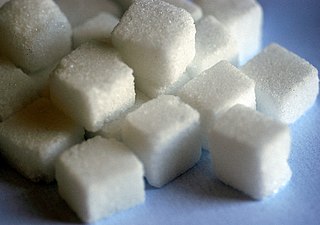
In human nutrition, empty calories are those calories found in beverages and foods composed primarily or solely of sugars and/or certain fats and oils such as cholesterol, saturated or trans fats, that provide little to no useful nutrients such as protein, fibre, vitamins, minerals, essential fatty acids, or antioxidants. Foods composed mostly of empty calories have low nutrient density, meaning few nutrients relative to their energy content. The consumption of large amounts of empty calories can have negative health consequences.
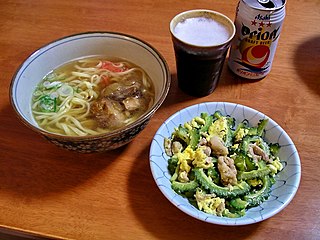
Okinawan cuisine is the cuisine of the Okinawa Prefecture of Japan. The cuisine is also known as Ryūkyūan cuisine, a reference to the Ryukyu Kingdom. Due to differences in culture, historical contact between other regions, climate, vegetables and other ingredients, Okinawan cuisine differs from mainland Japanese cuisine.
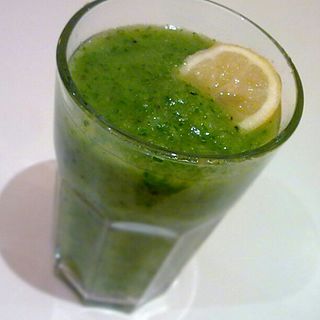
A very-low-calorie diet (VLCD), also known as semistarvation diet and crash diet, is a type of diet with very or extremely low daily food energy consumption. VLCDs are defined as a diet of 800 kilocalories (3,300 kJ) per day or less. Modern medically supervised VLCDs use total meal replacements, with regulated formulations in Europe and Canada which contain the recommended daily requirements for vitamins, minerals, trace elements, fatty acids, protein and electrolyte balance. Carbohydrates may be entirely absent, or substituted for a portion of the protein; this choice has important metabolic effects. Medically supervised VLCDs have specific therapeutic applications for rapid weight loss, such as in morbid obesity or before a bariatric surgery, using formulated, nutritionally complete liquid meals containing 800 kilocalories or less per day for a maximum of 12 weeks.

Proteins are essential nutrients for the human body. They are one of the building blocks of body tissue and can also serve as a fuel source. As a fuel, proteins provide as much energy density as carbohydrates: 4 kcal per gram; in contrast, lipids provide 9 kcal per gram. The most important aspect and defining characteristic of protein from a nutritional standpoint is its amino acid composition.
Blue zones are regions in the world where people are claimed to live longer than average. Examples of blue zones include Okinawa Prefecture, Japan, Nuoro Province, Sardinia, Italy, the Nicoya Peninsula, Costa Rica, and Icaria, Greece. The name "blue zones" derived simply during the original survey by scientists who "used a blue pen on a map to mark the villages with long-lived population."

A low-fat diet is one that restricts fat, and often saturated fat and cholesterol as well. Low-fat diets are intended to reduce the occurrence of conditions such as heart disease and obesity. For weight loss, they perform similarly to a low-carbohydrate diet, since macronutrient composition does not determine weight loss success. Fat provides nine calories per gram while carbohydrates and protein each provide four calories per gram. The Institute of Medicine recommends limiting fat intake to 35% of total calories to control saturated fat intake.

The Western pattern diet is a modern dietary pattern that is generally characterized by high intakes of pre-packaged foods, refined grains, red meat, processed meat, high-sugar drinks, candy and sweets, fried foods, industrially produced animal products, butter and other high-fat dairy products, eggs, potatoes, corn, and low intakes of fruits, vegetables, whole grains, pasture-raised animal products, fish, nuts, and seeds.
The anti-aging movement is a social movement devoted to eliminating or reversing aging, or reducing the effects of it. A substantial portion of the attention of the movement is on the possibilities for life extension, but there is also interest in techniques such as cosmetic surgery which ameliorate the effects of aging rather than delay or defeat it.
Hara hachi bun me (腹八分目) is a Confucian teaching that instructs people to eat until they are 80 percent full. The Japanese phrase translates to, "Eat until you are eight parts full", or "belly 80 percent full".

Added sugars or free sugars are sugar carbohydrates added to food and beverages at some point before their consumption. These include added carbohydrates, and more broadly, sugars naturally present in honey, syrup, fruit juices and fruit juice concentrates. They can take multiple chemical forms, including sucrose, glucose (dextrose), and fructose.

Soul food is a kind of African American cuisine that encompasses a variety of fried, roasted, and boiled food dishes consisting of chicken and pork meats, sweet potatoes, corn, leafy greens and other vegetables. Soul food has long been embedded in African American culture, but pushes towards healthy eating habits, for both physical and mental health, have adapted soul food cuisine to fit within health trends. This article will describe modifications of traditional soul food within health trends, including soul food with low carb, soul food with low sugar, soul food with low fat, soul food for vegan and soul food in gluten-free.
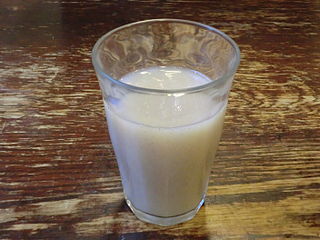
Miki is a Japanese drink from Amami Oshima, Kagoshima Prefecture and Okinawa Prefecture, areas known for health and longevity. It is an arrangement based on omiki, a beverage used in Shinto rituals and festivals. Miki is made from fermented rice, sweet potatoes, and sugar and was traditionally made in every household on the island. It is sold commercially as a soft drink, with many specialized shops selling it, and some grocery stores.
The relationship between diet and longevity encompasses diverse research studies involving both humans and animals, requiring an analysis of complex mechanisms underlying the potential relationship between various dietary practices, health, and longevity.